
This content is intended for students who are exploring the role of a owner or representative of the owner as a part of a Built Environment Innovation Challenge. In this context an "owner" refers to and individual, group, organization (or their designated representative) that has a lawful, undisputed claim to fixed property (e.g. land, stationary facilities, or infrastructure) who has an "expressed requirement" (as defined in Phase One of the challenge).
The owner's role and participation in establishing a successful project team (one that is enabled to deliver a successful project) is particularly important. This may start with the owner summarizing the "5W's" of an "expressed requirement" (as described in Phase One of a Built Environment Innovation Challenge) into a clearly written Request For Support (RFS) for open-source Planning and Project Development (PPD) from the community of built environment industry professionals, experts, educators, and students. This fundamental initializing content contributed by owners should concisely capture the extent of relevant subject matter that an open source project team must deal with during planning, design, and delivery in order to satisfy the full requirement at the owner's property. It must clearly establish the main performance objectives (ecological, financial, functional, and aesthetic), and spatial and temporal limits for the set of alternatives to meet the requirement. This initializing content may be posted in blog form (e.g. on the BEIC blog) for general access and comment, and a "Git" repository (e.g. on GitHub) for fostering collaboration with version control.
The Owner's Deliverables
A clearly written RFS for open source PPD from an owner should demonstrate key characteristics of an effective owner and solicit for team members with designer and constructor expertise. Include the following content:
1. Summarized requirement 5W's
- Clarity on each is a key characteristic of the owner's role. Be particularly clear on why the project is important and set expectations of project team members accordingly.
2. Main performance objectives and spatial and temporal limits for the set of alternatives to meet the requirement.
- This is critical value defining content and should be captured in the Project Scope Descrition (Appendix A) of an integrating execution agreement.
- Effective owners have the characteristic of commitment to Integrated Project Delivery as a means to find problems (early and often) with meeting or exceeding their expressed requirements. This is when implementing solutions has lesser cost and risk than later in project execution.
3. Timeframe allotted for the PPD effort.
- Depending on the complexity of the requirement and resources available to the owner the timeframe might range anywhere from a year to a one-day hackathon.
- The key characteristic of engagement demonstrated by effective owners manifests itself as continuous involvement with designers and constructors during the timeframe allotted for PPD effort.
4. Budget allotted (by hours and rate) broken out for designer and constructor consulting support.
- The owner should allot a budget sufficient to cover the costs of the PPD effort that includes the following activities:
- Defining the project funding sources and associated requirements.
- Defining the owner chain of command is essential for exercising the key characteristic of leadership that is essential for effective owners making timely and informed decisions during project execution.
- Selecting the Integrated Project Team.
- Negotiating an Integrated Project Delivery Contract.
- Choosing the Integrated Project Delivery Contract Type.
5. Open-source standards and licenses for content such as:
- Analysis of alternatives to meet the requirement with recommended alternative.
- Signature-ready project execution agreements for Integrated Project Delivery (IPD).
- Integrity is a key characteristic of effective owners and adopting open source methodologies and licenses sets a tone of openness and transparency that fosters the trust-based relationships essential to IPD execution.
6. Knowledge, skills, abilities, and experience desired of team members such as:
- Work on similar requirements.
- Experience with Integrated Project Delivery or familiarity open source collaboration project teams.
- Experience or familiarity with using shared file servers and collaborative Information Technology tools.
- Experience or familiarity with high-performance fostering management techniques (e.g. Lean) on cross disciplinary teams.
See Contribute.md for information about contributing to this project repository.
Content in the BEIC Project Based Learning Challenge repository is licensed as described in License.md.
All content contained in the BEIC Project Based Learning Challenge repository is for educational purposes only. Please see Disclaimer.md for more information.